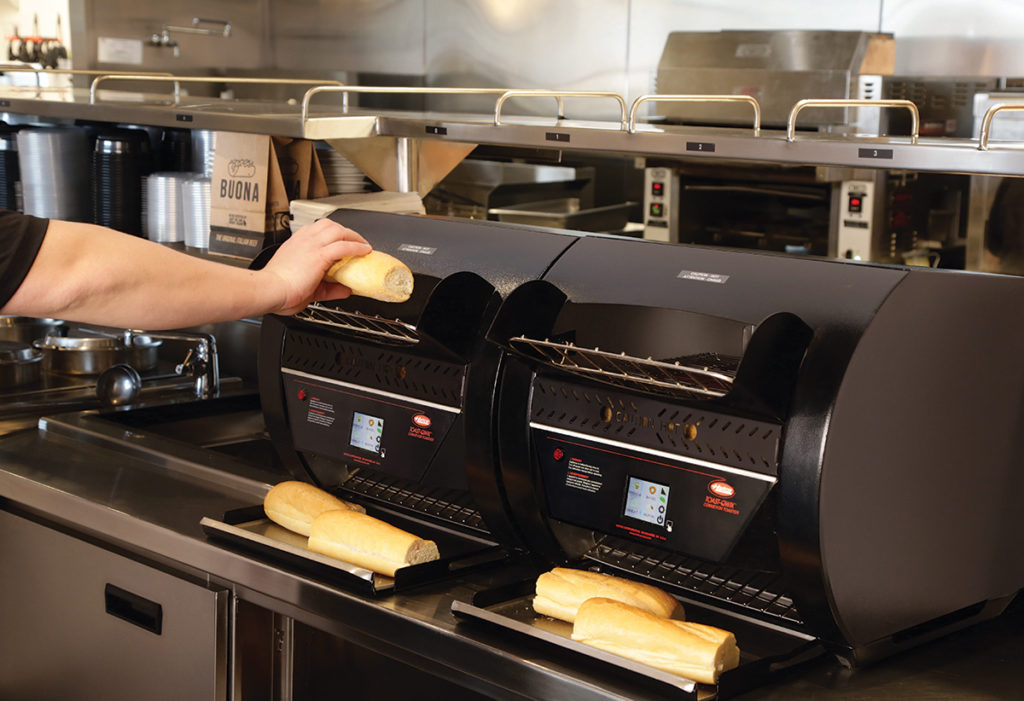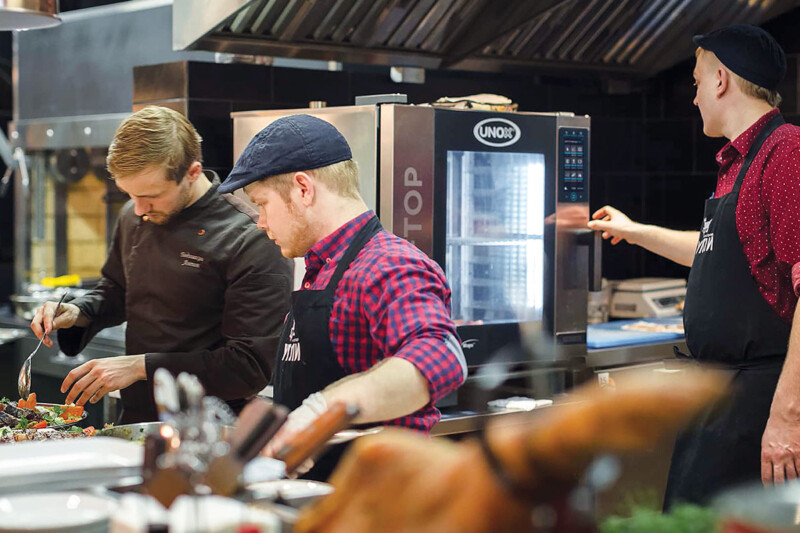
Who doesn’t like toast? Bread, bagels, English muffins, dry, buttered, slathered with jelly, jam, marmalade, Nutella or mashed avocado, toast is a staple not just at breakfast but anytime. Without it there would be no “T” in BLT, no “S” in a soldier’s “SOS,” and no raft for Adam and Eve at the diner.
Most of us are familiar with the four-slice pop-up toaster, and those of you who are serving a ton of sandwiches on a bun likely are using a specialty toaster like a contact bun toaster. Most foodservice operations fall somewhere in between, making them ideal candidates for conveyor toasters because they’re fast and versatile. You simply load slices of bread on the conveyor and they’re delivered toasted within seconds.
Power And Size
Conveyor toaster capacity ranges from about 250 to 1,800 or more slices per hour, depending on the model. The two primary factors that determine that capacity are size and power.
A lot of you may step up to conveyor toasters to meet customer demand from a menu addition or expanded daypart. You want something that is virtually plug-and-play, which means a toaster that operates on a 115V120V circuit. That’s all well and good if you only need about 400 or fewer slices per hour.
The exact same unit wired for 208V, 220V, 230V, or 240V likely will produce around 1,000 slices/hr. or more. The higher the voltage, the more wattage makers can pack into the toaster. A 120V, 15-amp unit can generate about 1,800W max. But go up to 240V, and you’ll see models with up to 4,850W. Big difference, but you need to plan where you’re going to park your toaster so you have the right electrical service in place.
Size is the other factor. Many base model conveyor toasters have belts 10-in. or 10½-in. wide—enough for two slices of bread side by side. But many manufacturers make models between 13-in. and 14½-in. wide, which typically fits three slices abreast. They don’t take up much more counter space, but they increase throughput by 50% or more. Some manufacturers also make stackable models, in essence doubling output in the same footprint. Pay attention to the breads you’re going to buy; if they’re larger than standard, and you thought you’d send two pieces through side by side, you’ll have cut your production in a half because your bread brand can only fit through one slice at a time.
Does Product Fit?
To that point, the height of your products matter a lot too. The other dimension you need to consider is the toaster opening. The standard height opening is 2 in., which accommodates most bread products. For really thick products such as bagels or Texas toast, some models are made with a 3-in. opening. There also are models with 1½-in. openings. The advantage of the narrower opening, one maker says, is a more energy-efficient unit since less heat can escape the opening.
Another manufacturer coats the wires inside the toaster that guide product to the delivery chute with Teflon to ensure a smooth, jam-free post-toast exit.
When You’re Hot You’re Hot
All conveyor toasters use radiant heat to toast, but some also add convection in one form or another to speed the process by drawing moisture out of the product. Radiant heat can come from one of two sources, metal-sheathed cal-rod or quartz heating elements. Quartz elements heat up faster but can be more fragile and tend not to last as long as metal. One maker has a pass-thru unit with ceramic heating elements on top that it says are more durable than quartz, and metal elements on the bottom that stand up to dripping grease and crumbs.
Toasters with convection in addition to radiant heat often are faster than those with only radiant heat. Some simply use a fan to force air through the cooking chamber in much the same way as a convection oven. Others use impingement-style convection, forcing air through holes or nozzles to direct hot air onto the product. Again, the idea is to strip moisture away from the product surface to allow it to toast faster.
Models feature separately controlled upper and lower heating elements give you the option of one-sided and two-sided toasting so you can toast bagels (on one side only) and breads in the same unit, for example. Others are double-deckers, with two, separately controlled toasting chambers for different types of product.
Proper Conveyance
Conveyors are typically constructed of stainless. Look for belts that have heat-resistant bearings; they’ll last longer. At least one maker uses brass bearings instead of stainless, for example. Some toasters allow you to control belt speed, one of the ways in which you control the degree of browning. A few models have dual belts, letting you toast different products at the same time—bagels on one side, toast on the other, for example.
Making It All Simple
Depending on the make and model, toasters may let you set conveyor speed, temperature or both to control the toasting cycle. Some automatically set the conveyor speed by monitoring the cavity temperature.
You can program toasting cycles for the breads you use on a number of models. Many have at least four pre-set programs that you can change to your specs, providing consistency from store to store. Some have 12 pre-sets, a couple of models have as many as 20, and one model has no limit to custom product settings, according to the maker. Newer models can be programmed easily through a USB port, which also serves to download data for service techs when the unit needs maintenance.
Most models operate simply with turn knobs that control belt speed and temperature of both upper and lower heating elements (if separate). A couple of makers have models with touchscreen controls that walk you through your choices. Several models have sensors that actually monitor the color of the product automatically adjusting heat or speed to ensure consistent results.
Saving Watts; Safety, Too
Conveyor toasters typically have an idle mode that users either turn on manually with a switch or program to turn on automatically after a period of time. Idle mode reduces power to the toaster, providing 50%-75% energy savings depending on the type of heating elements. Some models also have sensors that can tell when product is on the conveyor—and signals the conveyor to stop running when empty. Frontier Energy, operating the Food Service Technology Center in San Ramon, Calif., is conducting an ongoing plug load study to determine the amount of money operators can save by engaging the energy saving modes of light-duty, plug-in equipment. FER covered the results at its 2018 Multiunit Foodservice Equipment Symposium in January this year (See “Under The Radar: Plug Loads,” p. 48). Most models have “cool-to-the-touch” exteriors, either insulated, air-cooled or both, to protect users from burns. Safety features often include a high-limit switch that prevents toasters from overheating, and/or a temperature-controlled fan that runs until the unit cools to a specific temperature.
Watch Your Warranty
Prices on conveyor toasters run from about $550 for a base model up to about $3,500 for a “smart” digital, programmable model with all the bells and whistles and 1,800 slices/hr. capacity.
As always, check warranties. Most offer at least one year, parts-and-labor warranties, but the heating elements, whether metal or quartz, may come with a different warranty. Also, make sure the vendor’s service network covers the territories where you have operations.
Toast Tips
Excessively moist bread—especially breads with a high sugar content—can sometimes stick when they’re put directly onto the hot conveyor chain belt. The moisture causes a caramelization effect that makes the bread adhere to the hot metal and as it reaches the point where it should release, it can’t break free. Back it rides into the toaster for a too-toasty second run. You can reduce moisture by letting your breads dry out a bit. Train employees to remove moist breads from their plastic packaging and stage them ready to load near the toaster; even a little air exposure will begin to dry them out. And don’t let employees bypass the loading rack or slide; they might think they’ll save time by placing the bread directly onto the conveyor, but the slide-loader is there for a reason. Train them to empty the crumb tray every day, too.
Click to the next page for the Conveyor Toaster Gallery.
RELATED CONTENT
- Advertisement -
- Advertisement -
- Advertisement -
TRENDING NOW
- Advertisement -
- Advertisement -
- Advertisement -


